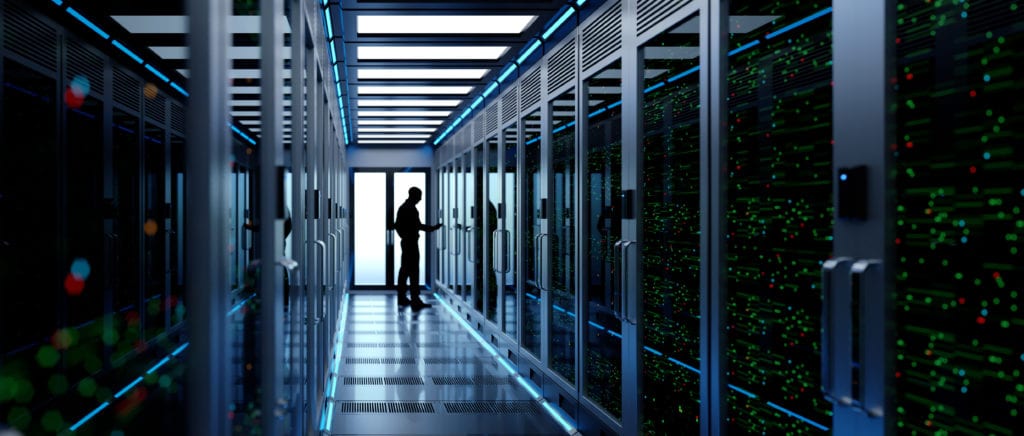Modern data centers have grown to become as large as industrial-scale facilities. More often than not they’re perceived and treated as such by the authorities, as well as by the media and local communities. This is reflected in all areas of the data center design and operation, which have an impact on the facilities’ environmental footprint, most notably in power utilization and on-site power generation. The environmental impact resulting from energy consumption is commonly reduced by switching to renewable power purchase agreements. At the same time, there is also an evolving trend to eliminate local emissions by replacing back-up diesel generators with alternate technologies.
Medium speed gas engine technology as an alternative to conventional solutions
Medium-speed gas engine generators represent one of the most proven alternate technologies. The term “medium-speed” in this context refers to reciprocating engines with a rated shaft speed of between 400 and 1200 rpm. Medium-speed engine technology is generally utilized in heavy-duty applications for baseload and intermittent operation, for instance in engine power plants and ships. The benefit of gas engine technology as compared to diesel engines is its use of an inherently cleaner fuel. Furthermore, the lower shaft speed offers considerably higher efficiency (reaching up to 46 %) than can be achieved by typical high-speed diesels used for backup power. In fact, reciprocating engine technology is the most effective simple-cycle combustion engine technology available today. Given the typical output of medium-speed gas engines (approximately 4…12 MWe), they are well suited for larger data centers requiring 10 MWe or preferably more of continuous load.
WP 286: Applying Natural Gas Engine Generators to Hyperscale Data Center
Why then hasn’t such a technology been applied earlier? In the past, gas engine technology, as opposed to diesel engine technology, was burdened with lower dynamic capabilities for fast start-up and loading. With diesel engines, load transients can be met by overdosing the engine with fuel, the drawback of which is a thick plume of black smoke because of the non-optimal fuel-air mixture. This same approach is not possible with gas engines, since if the air-fuel ratio in the cylinder is too low, it may lead to the formation of an explosive mixture in the exhaust duct. With modern gas engines, however, this problem has been overcome with the help of cylinder specific fuel ignition and combustion control.
Another challenge has been the industry’s requirement for on-site fuel storage, which previously had not been possible or feasible for gas-based technologies. However, productization and the widespread utilization of Liquified Natural Gas (LNG) technologies, such as LNG bullet tanks or gasification and liquefaction units, have overcome this drawback. Today, LNG applications are commonplace both for off-shore and land-based applications and can be encountered equally well in a bus fuel depot as on a passenger ferry. Separate fuel storage may not even be needed in many cases, since the inherent reliability of the gas grid typically exceeds the reliability requirements of the data center. For instance, gas grids are not as prone to earthquakes or storms as electricity transmission and distribution grids.
Gas engine technology in the context of data centers – A quantum leap or not?
Research teams from both Wärtsilä and Schneider Electric co-authored White Paper 286: Applying Natural Gas Engine Generators to Hyperscale Data Centers which discusses how gas engine power plants can be practically integrated into the design of hyperscale data centres, and what the implications of this may be. One obvious consideration is that of the physical dimensions and electrical capacity of the generating sets, with the natural power distribution arrangement being a centralized model instead of a distributed one. For this purpose, Schneider Electric has developed a ring bus power distribution scheme.
Studies presented in this paper first reveal that in terms of availability, the centralized captive arrangement of gas engine generators in an “N+R” configuration is comparable to a typical 2N configuration with diesel engine generators combined with a grid connection The N refers to the number of generators satisfying the design basis load of the data centre and R refers to the redundant units. In order to further enhance the availability of the gas engine solution, a novel concept utilizing a limited grid connection has been introduced. In this concept the data centre would have a smaller medium-voltage connection of, say, 10MW instead of a full-scale high-voltage connection. This connection would be utilized mainly to act as a provisional supply to cater for planned engine overhauls instead of investing in additional redundant gas engine generators. The benefits of such a connection are smaller tariffs, a lower short-circuit capacity, and a faster permitting process.
For this paper, a total cost of ownership analysis with the prevailing tariffs and costs in Ireland was also carried out. The analysis revealed again that a captive gas engine plant is comparable to that of a diesel-backed grid supply… and this does not take into account the other potential revenue streams briefly introduced in the white paper. These potential revenue streams can be grouped under the following headings:
- A self-generation model with heat recovery schemes
- A merchant plant model for energy trading
- A fast deployment model to support the data centre’s build-up and expansion before grid connection
- A split ownership model for less capital-intensive investments
- A hedging renewables model, in which data centres take an active role in supporting the further integration of volatile renewables.
 Considerations for on-site power generation – read the full white paper
Considerations for on-site power generation – read the full white paper
Despite the comprehensive and multidisciplinary efforts required for this white paper, a number of new interesting and uncharted areas of combined development were identified; areas where both Schneider Electric and Wärtsilä have profound technological know-how. These areas include, for instance, the utilization of waste heat from the power plant for cooling the data centre, and the integration of the power plant and data centre’s control and management systems.
Read the full White Paper 286: Applying Natural Gas Engine Generators to Hyperscale Data Centers, to understand how natural gas engine generators could be a consideration for your data center.



